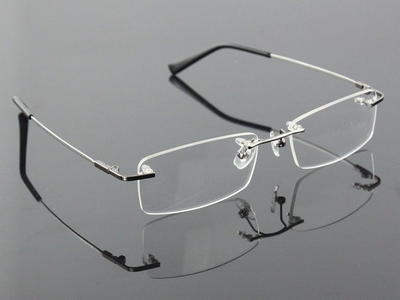Titanium spectacle frames were developed and manufactured in batches abroad in the early 1990s. Before 1998, titanium spectacle frames had occupied more than 60% of the Japanese market. The first titanium spectacle frames in the world were sold under the names of TitexA and TitexB since 1981. The problems of die breakage and surface finish during drawing and stamping were solved by using TitexA. The optimum cutting conditions of the machined surface are obtained. In surface processing, focus on additives, polishing rolls, processing machinery, processing conditions and so on. Breakthroughs have also been made in the development of new solders for titanium. In surface treatment, it is difficult to treat titanium by wet electroplating of precious metals on materials (zinc white copper, nickel alloy, stainless steel, etc.) before, so the method of ion plating is used. Golden yellow can be obtained by nitriding and silver white can be obtained by chromium nitride. In addition, these nitrides are superhard materials, which give the surface a good wear resistance. In addition, brown and yellow can also be obtained by spraying. Titanium spectacle frames belong to high-end consumer goods. In recent years, with the improvement of people’s living standards, the domestic demand for titanium spectacle frames has expanded rapidly, and many manufacturers of titanium spectacle frames have appeared in China. Titanium for spectacle frames is currently used in pure titanium, Ti-Ni alloy and beta titanium alloy. Its advantages are corrosion resistance, light weight, superelasticity and color-invariant, which are welcomed by consumers.
Classified pure titanium frame: except for screw and plastic foot cover, the metal part of the frame is made of titanium material. Nickel-coated titanium: The frame is made of titanium, and the surface is made of nickel-coated material. Now this kind of frame no longer exists. Assembly Titanium: Because of the high cost of producing nickel-coated Titanium and the need to update the equipment, the assembly of titanium mirror frames came into being before the updating. However, this product is dangerous, because each metal has different melting points, it will be very fragile to combine them. Early nickel-coated titanium frame after flattening angle, its frame distribution can not be as average as the original factory production, so after use, the nickel and titanium coated layer will break off and can not be repaired by welding, including assembling titanium. Nickel-Titanium plating: In order to reduce costs and make production more convenient, some factories have developed the use of titanium metal plating nickel metal. In this way, the traditional welding technology can be used. In order to prevent bad vendors from using titanium alloy frame as pure titanium frame, consumers can refer to the following description for identification. Titanium spectacle frames, according to the type of use of titanium parts, are printed in abbreviated form on the frame, generally in the foot of the mirror, as long as you pay careful attention, it is easy to distinguish. Due to customer needs, there are pure titanium frame, Beta titanium frame and semi-titanium frame, semi-titanium frame is divided into titanium alloy frame, such as memory titanium, biological titanium, etc. Titanium-gold combination, namely: pure titanium or beta titanium and metal combination frame, such as pure titanium for mirror leg, metal for frame, beta titanium for mirror leg, metal for mirror leg, etc. Combination frame of pure titanium or beta titanium with plate or TR material, such as pure titanium for mirror leg, plate for frame, beta titanium for frame, TR for mirror leg, etc.

